Chris Baty's Blog, page 138
October 14, 2016
NaNo Trick or Treat: The Red Wire! No, the Blue One!

Everybody knows that Tumblr loves Halloween, and that Halloween heralds the
start of NaNoWriMo! To get into the holiday spirit, we’ve asked Wrimos from around the world to share the best “trick” and best “treat” they know to help themselves reach 50K in November. Today, participant Marissa Monteiro shares how to disarm the ticking time bomb of your novel:
I must begin this post with brutal honesty: last year I attempted NaNoWriMo and I did not win. This was not a complete surprise given that I had no story in mind, made no preparations, and did not heed any of the warning posts about how hard it is to actually write 50,000 words in a month.
It was a sobering failure, but by the time Camp NaNoWriMo rolled around in July, enough time had passed that I was able to convince myself all over again that I could take on an unreasonable writing challenge. But this time? I WON. I learned from my mistakes and did not repeat them. If you are on your way to becoming a loser-turned-winner like me, here are two ways to trick yourself into the sweet, sweet treat that is reaching the word count goal.
Trick:Invent a reason to write every day. All that science and advice about habit is true, but “scientifically proven” isn’t enough of a reason to make me do it, so I made up a more compelling imperative. For Camp NaNoWriMo, I pretended that there was a poem hidden inside me that needed to get out in the world, and if I didn’t get it out by the end of the day it would self-destruct and explode like a literary time bomb. (This kind of delusion is also how I trained myself to look behind me before backing the car out of the driveway: “Check for unicorns and fairies in the rearview mirror!”)
Ridiculous? Maybe, but it turned writing into an everyday adventure. Suddenly the hero of my own NaNo experience, I kept a daily practice of rooting out fresh new words. This was very different from my first NaNo attempt, which involved lots of “I’m too busy” and “I have nothing to say” days. Whether it was a trickle or a flood, the flow of writing remained in flow because it was regularly turned on. By the middle of the month I started to feel like I needed to write in the same way that I need to brush my teeth and shower to feel like a normal human being. By the final week I was so adept at discovering and disarming word-bombs that I stopped wondering whether I would reach the goal. I knew I would.
Most writers I’ve met have very active imaginations and are liable to believe their own stories. Maybe you don’t need to turn writing into an act of self-preservation like I did, but try coming up with a way to make it an adventure rather than a chore.
Treat:Make your desk into a cozy haven. Rather than locking myself into an austere jail cell as punishment until I write enough, I like to make my writing space inviting so that I look forward to going there all day. I light a fancy candle, cover my desk with life-affirming Oprah quotes, hang up artwork that makes me think of my story (currently a saucy silhouette of two figures embracing for a romantic story about a dance affair), and allow myself to add whipped cream and cinnamon to my coffee.
Sure, I could be a suffering artist, but why would I do that when I could be a comfortable artist? The world may tell you otherwise, but you’re allowed to enjoy writing. I do this because I like it. And because if I don’t this novel might take out my spleen.

Marissa has a degree in English Literature because when she was a child she believed she was the next Matilda. Though her reading-based telekinetic powers have yet to surface, she is still consuming books at an alarming rate. She lives in Seattle and is extremely thankful that its stellar library system has fed her appetite for good stories without draining her bank account. You should check out this song she wrote during Camp NaNoWriMo, and you can follow her on Tumblr at coffeecanrevolution.
Top photo by Flickr user DavidZerious.
October 13, 2016
Research and Reading: Gathering Books to Help Your Novel Take Shape
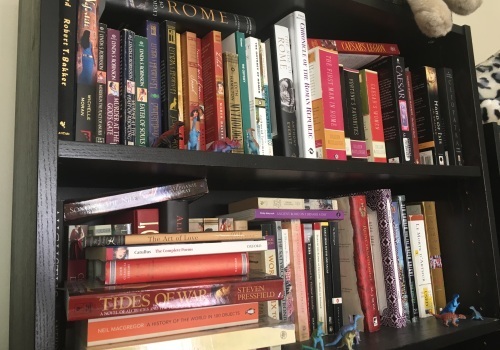
All writers have known the joy of being lost in a good book. This month, we’ve asked NaNoWriMo participants from around the world to share their personal libraries with us–the books that give them insight, inspiration, and that keep them turning the pages again and again. Today, Cass Morris, participant and author of the upcoming novel A Flame Arises, talks about how her bookshelves shape both her life and writing:
My bookshelves are chaos. I think I’m about three cases short of how many I’d need to actually shelve all of my books without having them stacked two and three deep. I’m a confessed book hoarder and a bit of a literary Luddite; I only got an e-reader last year, and I still only use it for traveling. I like physical books precisely because of these shelves: They tell anyone entering my apartment who I am. And now, I get to share that with the NaNo community! I’ve taken pictures of the two that are most relevant to my current series-in-progress:
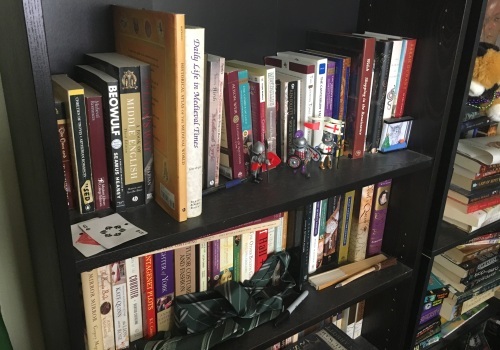 Historicals
HistoricalsThese shelves are arranged chronologically by topic, mixed fiction and non-fiction. They are also guarded, as you can see, by dinosaurs and knights (my bookshelves also have a habit of attracting toys and knick-knacks).
Those top two shelves contain the most books that have directly influenced the writing of A Flame Arises. Some are reference books–I’m particularly fond of Alberto Angelo’s A Day in the Life of Ancient Rome and Philip Matyczak’s humorously-inclined Legionary and Ancient Rome on Five Denarii a Day. Some are fiction, like Colleen McCullough’s excellent Masters of Rome series. The female-centric focus of historical fiction writers like Kate Quinn, Michelle Moran, and Stephanie Dray is also something that really speaks to me.
The sheer density of those books is so impressive–but also something I had to be careful not to let influence me too much. Too much history can bog down a narrative. I can’t include a ten-page treatise on the voting procedures of the Tribal Assembly in the middle of what’s supposed to be a tense scene. (I mean, I could…and that’s a great way to up a NaNo word count! But it’s the sort of thing my agent and editor are quick to put the kibosh on.)
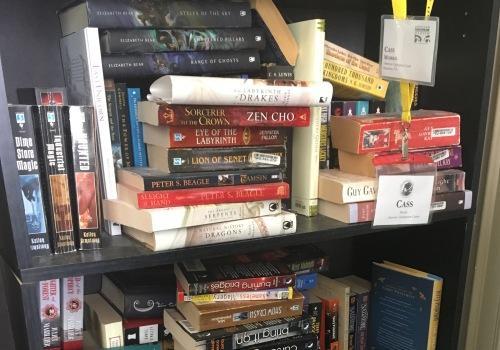 Fantasy
FantasyThese shelves, as you can see, overflow. They’ve expanded leaps and bounds in the past few years, as my agent and editor have both made recommendations to me of authors whose work mine might profitably be compared to. I’ve also been making a concentrated effort to read more diversely–both from diverse authors and stories featuring a diverse cast, and these shelves reflect that.
Other authors have been with me for a long time. Neil Gaiman and Terry Pratchett helped form a lot of my mythopoeic worldview, and I yearn for the lush stylistic elegance of Catherynne Valente. The most recent addition here is Zen Cho’s Sorceror to the Crown, which I just adore for being a thoroughly creative and well-woven historical fantasy.
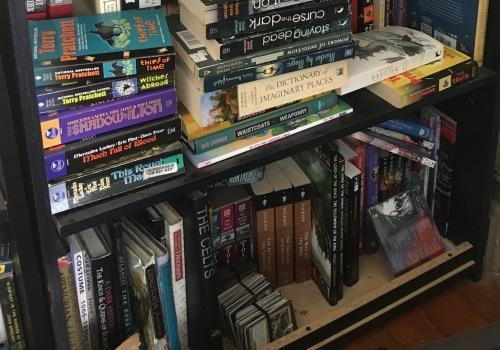
I love my bookshelves for what they say not just about who I am, but where I’ve been. I can see a book and remember when I bought it, where, and why–and I can remember what my life and my writing were like then.

Cass Morris is, by day, a Shakespeare educator who develops classroom resources, writes teaching guides, and leads workshops and seminars. A graduate of Mary Baldwin University and the College of William and Mary, she lives in western Virginia with two royal felines, Princess and Ptolemy. She reads voraciously, wears corsets voluntarily, and will beat you at MarioKart. Her debut novel, A Flame Arises, began life as a 2011 Nano novel and will be released through DAW Books in September 2017.
October 12, 2016
Why I'm Renting a Castle for NaNoWriMo

Have you ever dreamed of taking a month-long writing retreat somewhere exotic and beautiful–say, perhaps, a castle in France? This year, a group of Wrimos is making it happen! Author Derek Murphy shares the reasons why he decided to go all-out this November–and how you could win a free stay in the castle next year!
A few years ago I wrote a defense of NaNoWriMo and #amwriting in response to an article griping about the devaluation of literature. In my post, I compared NaNoWriMo to endurance training: you have to force yourself to write quickly so you can get something finished, and move past the whispers of self-criticism that would otherwise slow you down.
At the time, I thought that NaNoWriMo was kind of like training wheels, and I’d moved past it. But I was wrong.
After publishing four books this year, I’ve come to appreciate some of the more subtle benefits of NaNoWriMo. I knew I wanted to do NaNoWriMo hard this year and finish at least one, possibly two books: and I wanted to do it with other people. Although I love the online support and community, I really wanted to live together with a group of hard-working writers, all writing our books, together, and doing nothing else. I wanted somewhere beautiful, spacious, historical and inspiring–so, I decided to rent a castle in southern France (it wasn’t as expensive as you might think).
 The Grand Gesture Model
The Grand Gesture ModelIn Deep Work, Cal Newport introduces the “Grand Gesture” model of productivity, which involves doing something really big to keep you focused on accomplishing a goal. For example, J.K. Rowling checked into a suite at the 5-star Balmoral Hotel, down the street from the Edinburgh Castle–one of her inspirations for Hogwarts–to finish the 7th Harry Potter book; she didn’t plan to stay there, but got so much done she returned every day (paying $1000+ a day for the suite).
Just participating in NaNoWriMo can be the big thing that helps you accomplish your goal of writing a novel. Investing in a grand gesture encourages you to take advantage of the situation you’ve created for yourself, because otherwise you’d be wasting the time and money. It doesn’t have to be expensive: maybe your grand gesture is buying yourself some fancy clothes and wearing them every day while you write. Maybe it’s taking a long walk through the park to let your characters talk to each other. Maybe you invite everyone to a celebration party at the end of the month to share the novel you’ve written. Maybe you buy a nice pair of noise-cancelling headphones.
It should be something a little impractical, something that you don’t need, but something that makes you feel good and helps you concentrate on your writing.
 Why a Castle?
Why a Castle?A lot of people were skeptical of my idea. It seems like an extravagant, even foolish waste of money. Other writers tell me, “I can write anywhere. Location doesn’t make a huge difference.” And that might be true (although they’ve probably never lived in a castle for a month, so they don’t know whether or not they would be inspired to get more work done).
Extravagance in this case is kind of the point: most writers will measure ROI (return on investment) based on word count. But the 50K I write in the castle, I think, will be worth more than 50K I wrote elsewhere, because:
The relationships I make with other writers and authors have value.Doing cool things that inspires writers is good for my author platform and visibility.
You are more than just the books you write: the story about the production of those books, your quirks and methods, your strange habits and hobbies, are all part of you author brand and can make it easier to find your readers. Sometimes, instead of asking people to share your book, you just have to give them something remarkable to talk about.

Renting a castle is important to me because I want to be the kind of writer who lives in castles and writes books for a living—it’s a big, affirmative step towards my ideal lifestyle. Of course my success will depend on whether or not readers like my books, but so far reviews have been good, so the most important thing for me to do now is to keep writing, using whatever tricks or tactics that get me to finish more pages.
This November, do whatever grand gesture you need to do to make your dreams become reality. Whether it’s totally unexpected, or something you’ve been aching to do for a long time; something you do with others or alone—set that big goal. Regardless of whether or not you finish your novel, you might just end up with the best story of your life.
P.S. We’ve already started planning for next year, and will be giving away at least two free rooms. You can sign up here for your chance to join us in the castle for NaNoWriMo 2017!

Derek
Murphy is a book designer with a PhD in Literature who now writes young adult
fantasy novels and lives in castles. On his site www.creativindie.com, he publishes tips, tutorials and case-studies
to help authors publish better-looking books and build author platforms that
support a profitable writing career.
October 11, 2016
From Our Young Writers: Choosing Your Own Path

In addition to the main event every November, NaNoWriMo provides free creative writing resources to educators and young participants around the world through our Young Writers Program. This month, we’ve asked some of our young writers to share their own words of wisdom. Today, Jenna O’del, young author of Hidden Presences , discusses how writing–and teaching–can help you discover your individual path:
Hello writers!
Are you ready to set sail on the writing ocean? To travel down the literary path? Shockingly, NaNoWriMo is only a few weeks away–but you’ll be fine, because we writers are stubborn, and can conquer any challenge we come across.
One of the biggest challenges a writer faces is forging their own path to becoming a writer. Every writer takes a different path. Some are long, some are short. Some wind like a worm, some are crossed by rivers and bridges, while still others include various drop-offs you’ll need to jump across.
My own path was (and still is) winding: bending between genres, taking me down different roads of reading, and finally leading me to teach what I learned to others. On this path, I learned much, including that just as everyone has their own path, everyone has their own writing style. Everyone writes their own story in a way only they can tell.
I relied on this philosophy when I taught creative writing workshops at my high school, during the second half of my junior year and the entirety of my senior year. These workshops, the idea of a non-fiction writer and fellow student, met weekly, giving students a time to do nothing but write, and discuss how to write various topics and genres. I learned just as much from teaching these workshops as my fellow students did—because a teacher, when he teaches, teaches himself.
“Through writing and teaching, I learned to look at everything from a thousand perspectives.”Teaching these workshops reminded me of the fact that from the little grain of sand to the mighty dragon, everything has its own story. That little grain is not just a piece of sand: it is a small sample of rose quartz, which saw the dinosaurs lumber by when it was part of a larger stone, and now watches the setting sun every night. The dragon meanwhile is a messenger, relaying words and magic between the planets of the solar system, where most of the dragons reside.
Teaching highlights various realizations: your impact on other people, new ideas about what you’re teaching, and revelations about yourself, as you work to ensure that the class you are about to give is one that will make your students come back to class again and again and again. You learn about how you, yourself, come up with ideas, and where you find them.
Through writing and teaching, I learned to look at everything from a thousand perspectives. I learned to wonder about the stories of the things I looked at every day. And I learned not just to look, but to see.
I learned to gaze into the things around me, to observe their environments. I learned to use all of my senses. I became more conscious of using detail in writing–the kind of detail that lets the reader not just read, but experience the story so vividly that it’s like they’re right in the center of the story.
When I write, I want to bring that experience to my readers. I want to make my readers as much a part of my story’s world as my characters are.
As I taught, or read another book, I remembered time and again that everything has a story, and everything can destroy, colorize, or turn another’s story upside down. Everything matters, and can have roles whose sizes are unimaginable until you figure out how they fit into your story.
So writers, good luck in adding another chapter (literally) to the story of your life, as you compose a tale of however many words you end up writing this November and beyond. If you get stuck, consider this: Since everything matters, you can make anything, from that little rose quartz grain to the messenger dragon, change the world of your own story.

Jenna O'del is the young Rhode Island author of Hidden Presences, the first of the Hidden Strength series. When not writing, sailing, or spending time with horses, she has taught creative writing workshops. The yet-untitled second installation of the Hidden Strength series will be published November 15th.
Top photo by Flickr user Derek Bruff.
October 10, 2016
Road Trip to NaNo: Expand Your Writing Toolkit
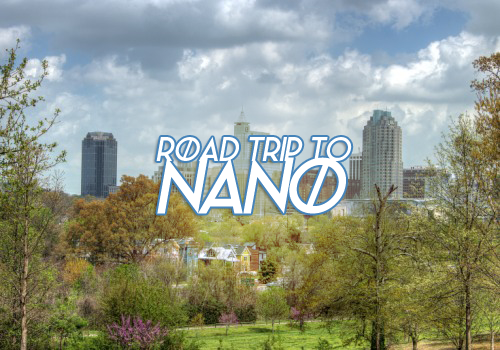
NaNoWriMo is an international event, and we’re taking a Road Trip to NaNo to hear about the stories being written every year in our hundreds of participating regions. Today, Moriah Blalock, our Municipal Liaison in the USA :: North Carolina :: Raleigh-Durham region, urges you to add some new tools to your writing toolkit:
Every Wednesday, I go to my favorite local coffee shop to work. Their tea lattes are heavenly, and the front porch offers a charming view of my hometown’s historic main street. Although it’s no longer the small town of 5,000 it was when I moved here, the feeling persists. My parents live 30 minutes to the south, surrounded by farmland. A hot air balloon festival takes place down the street every year. My brother-in-law lives 30 minutes to the north, in an urban neighborhood right between the area’s largest mall and a prominent historically black university. All three of these places are located in the Raleigh-Durham region of North Carolina.
My region is all about juxtaposition. A two-hour drive will take you to either the mountains or the ocean. You can visit the prize bulls at the State Fair, then head three blocks down the street to see the latest exhibit at the North Carolina Museum of Art. We’re quintessentially Southern—you can get a darn good sweet tea just about anywhere. But so many people have come here from up North that you don’t have to look hard for a decent New York-style pizza.
“Genre is, at its most basic, a toolkit.”The Wrimos in our region embrace juxtaposition in the ways they play with genre. We have one author who writes Christian fiction featuring zombies, and another whose contract killers advocate for lifelong education. Another of our authors has combined the best tropes from movies and comics to publish a trilogy of heart-wrenching superhero novels. By breaking out of the norms of the genre, each author has written a stronger, more compelling novel.
Genre is, at its most basic, a toolkit. The rules are flexible, but it isn’t easy to know which are bedrock and which are window dressing. The two methods below are my personal favorites for breaking away from the boring.
1. Visit the ForumsYou can’t discover new things if you never leave behind the familiar. Here, like anywhere else, you have to leave your neighborhood if you want to discover the unfamiliar. In NaNo Land, your neighborhood is your genre forum.
If you’re struggling with a specific part of your novel, the NaNo forum for your genre can be a godsend. Other fantasy writers are probably your best bet if you need a creative way to defeat a troll, after all. But if you’ve got the blahs about your whole project, pop into a forum you don’t usually visit. Let the horror forum villain discussions inspire the antagonist in your YA. Talk details and misdirection with the mystery folks to create extra tension in your literary fiction. Ask yourself the questions other authors are asking. You may be surprised to discover how much your novel has in common with theirs.
2. The Spaghetti Method—Throw Stuff at the WallThe downside to always having something new: lots of the new things don’t stick around. Sometimes, that cool restaurant goes under. My sleepy hometown isn’t the ideal place for a nightlife-focused wine lounge, I guess. But when you’re writing a novel, the stakes are lower. Maybe you’ll waste a few hours on a bad idea, but you’ll learn something from it.
Take everything you think you know about your genre and toss it out. Who says literary fiction can’t have wizards in it? What if the main characters of your romance novel were birds? Why can’t action-adventure take place on the moon? If you embrace even the most unlikely ideas, eventually one will be just crazy enough to work. And at the very least, a UFO landing will pad your word count, right?
So here’s my challenge to you this November: take some big risks. NaNoWriMo is all about trying to do something amazing by doing something a little bit bananas. You’re already being brave and pushing your limits. What could you achieve if you pushed them a little further?
NaNoWriMo in USA :: North Carolina :: Raleigh-Durham
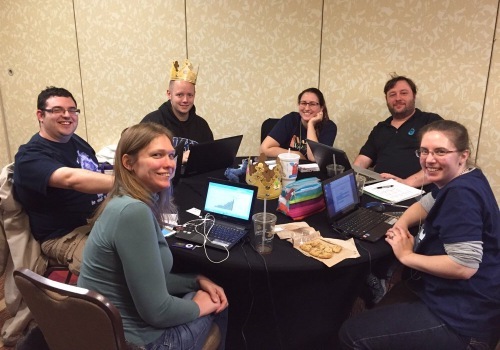
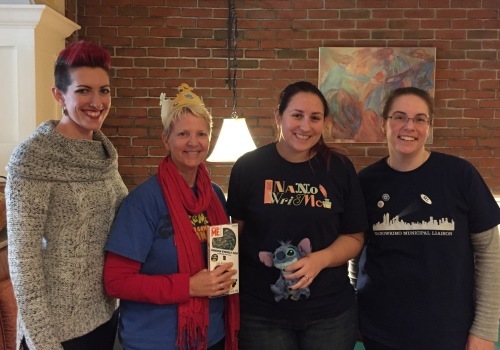

Moriah Blalock is heading into her first year as an ML. She lives in Apex, NC, with her husband, in a house that is going to collapse under the weight of all their books and musical instruments very soon. When not typing furiously and trying to keep the cat out of the tea cabinet, she is on the hunt for the perfect sugar-free pie recipe.
Top photo by Flickr user lisadonoghue.
October 7, 2016
NaNo Trick or Treat: The Netflix Binge

Everybody knows that Tumblr loves Halloween, and that Halloween heralds the start of NaNoWriMo! To get into the holiday spirit, we’ve asked Wrimos from around the world to share the best “trick” and best “treat” they know to help themselves reach 50K in November. Today, Amanda Rosa, our Municipal Liaison for the USA :: Puerto Rico region, shares her trick and treat advice:
As Halloween–and, therefore, NaNoWriMo–approaches us, it is time to prepare ourselves for November. After participating in NaNo for over 5 years, I have experimented with ways to help myself reach that 50k finish line. Now, I know which strategies work for me. In the Halloween spirit, I have to either trick myself or treat myself in order to sit down each day and finish a novel by the end of the month.
I love binge-watching television shows on Netflix and Amazon Prime. It is a guilty pleasure of mine after a long day of work and running around with my little boy. You can find me almost every night in bed, watching Doctor Who, New Girl, or whatever is my favorite show at the moment. However, my problem is that nighttime is also when I sit down to write–and you can bet I will always get distracted by Netflix.
That’s why during November, Netflix becomes my trick AND my treat. If I don’t sit down and reach my word count for the day, I will not let myself watch any shows. And the next day is the same. This motivates me to take the opportunity of any minutes during the day when I can write, so when nighttime comes, I am already ahead of my word count.
“Some days I even find myself not watching Netflix–not because I didn’t reach my goal for the day, but because I’m so deep in my story that I don’t care!”When I do reach my word count for the day, I get to put on Netflix, grab a Diet Pepsi with cookies, and enjoy my treat that I worked so hard for. It makes me enjoy my time relaxing since I know I achieved all my goals for the day. Some days I even find myself not watching Netflix–not because I didn’t reach my goal for the day, but because I’m so deep in my story that I don’t care that I already reached 1,667 words! I want to continue writing because I enjoy it.
Of course, the biggest treat of motivation for NaNoWriMo is knowing that at the end of November I can proudly say I’ve finished a novel–a novel I wrote because I made a commitment to myself–and that I enjoyed writing it. I can say that no matter how discouraged or busy I was, I am now one step closer to reaching my dreams. The novel may not be ready for the world, but with care during the after months (that is, the Evil Editing process), it will soon take shape and be ready for everyone to enjoy.

Amanda L. Rosa is a second-year Municipal Liaison who can’t stay in a genre. She writes everything from middle grade fantasy, YA Sci-Fi, and NA Contemporary to Adult Adventure. Amanda graduated with a bachelor’s degree in Geography from the University of Puerto Rico, a subject she always manages to include in her novels. When not writing she can be found running all over the house with her little boy, surrounded by yarn, or writing reviews online. You can follow her on Twitter @mandylola.
Top photo by Flickr user Kristina Alexanderson.
October 6, 2016
Spilling From Every Corner: A Guide to Making the Most of Shelf Space
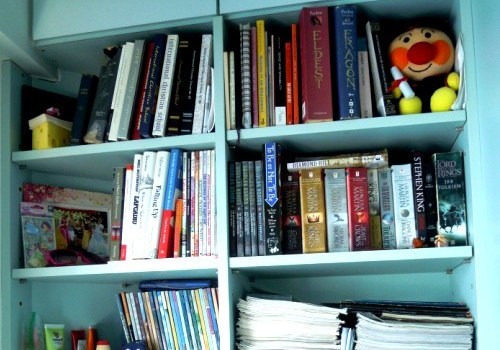
All writers have known the joy of being lost in a good book. This month, we’ve asked NaNoWriMo participants from around the world to share their personal libraries with us–the books that give them insight, inspiration, and that keep them turning the pages again and again. Today, Amanda Tong, our Municipal Liaison for the Asia :: China :: Hong Kong region, talks about utilizing bookshelf space in cramped quarters.
In Hong Kong, space is scarce. People cram into tiny flats stacked upon one another, reaching up to the sky as the “most vertical city in the world.” My bedroom is a cozy 8 x 6 foot box–where I’ve practiced the delicate art of using every available inch.
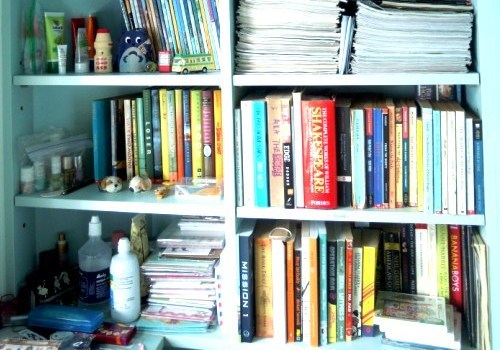
1. Main bookshelf. My main bookshelf is packed! There’s everyone from Laura Ingalls Wilder and Jerry Spinelli to Susanna Clarke and Douglas Adams. One row is dedicated to back issues of children’s magazines Cricket, Cicada, and Muse. But not all you see in this photo are ALL of my books…
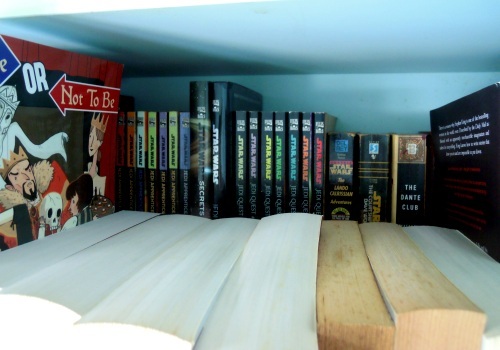
2. Back Row. Most shelves have TWO rows, like this collection of Star Wars lurking behind A Song of Ice and Fire! Say hello to my Sci Fi & Fantasy shelf.
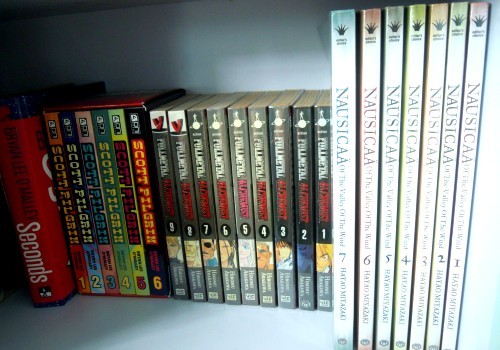
3. Manga Shelf. Draw back the sliding door beneath all this, and you’ll find manga and more comics. Seconds was my favorite read of 2015.
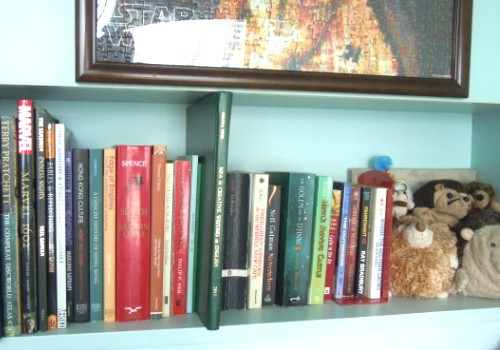
4. Bed Shelf. The nook at the foot of my bed is home to the oversized volumes that can’t fit anywhere else - mainly my MFA thesis and graphic novels like Marvel 1602. It’s also where I store my favorites: Fried Green Tomatoes, Neverwhere, The Golem and the Djinni, Goddess of Yesterday…and my hedgehog plushie collection. Six hedgehogs in total so far.
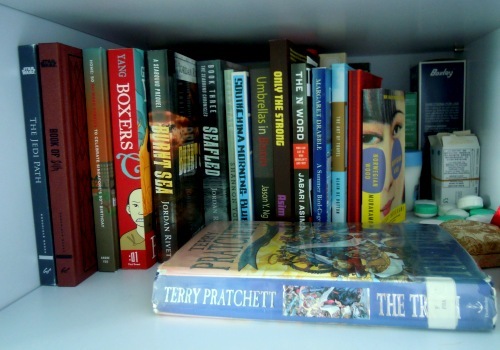
5. Cabinet Shelf. But it’s still not enough! I had to clear out part of my closet for books I’ve bought from local fairs and festivals. Many are by writers based here in Hong Kong. There’s also a library book. I should return that.
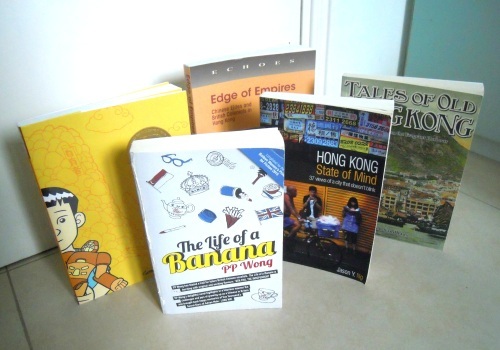
6. Book list. This year for NaNoWriMo, I’m writing about my city. I will create a mythical Hong Kong existing in the present and the past, visited by a main character both an outsider and a native. To get myself “in the zone,” I threw together a reading list for October. Fiction, nonfiction, even (once again!) a graphic novel. And after I’ve finished them, I’m going to have to find somewhere else to put them too…
For those with roomy homes, treasure your shelf space! In the meantime, I’ll just continue to squirrel books away until they’re spilling out of each corner–as they inevitably will.

Primary-aged Amanda would haul home entire boxes filled with books ordered from Scholastic’s colorful catalog. In secondary school, her friends learned to lend her two at a time since she’d usually finish the first one by lunch. Even with frequent use of libraries to save both money and space (a habit picked up during undergrad), books still manage to pile up on her bed, desk, and floor.
She teaches creative writing in her hometown of Hong Kong.
October 5, 2016
An Introduction to 30 Covers 30 Days 2016
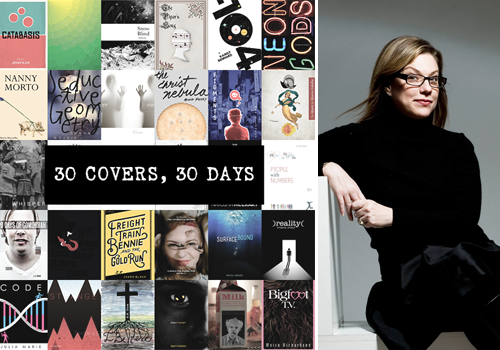
Happy planning month, Wrimos! The leaves are falling, the air is crisp, and it’s time for the annual tradition of 30 Covers 30 Days!
What is 30 Covers 30 Days?
Thirty very lucky Wrimos will be chosen to have a cover for their 2016 NaNo novel designed in just 24 hours by one of the talented designers recruited by our wonderful coordinator, Debbie Millman.
Debbie is a writer, educator, artist, brand consultant and host of the radio show Design Matters, not to mention president of Sterling Brands for the last twenty years and President Emeritus of the American Institute of Graphic Arts. So don’t worry, your novel is in very capable hands.
We’ll be posting a new cover every day of November, both on this blog and on our forums.
If you’d like to see what some of our previous covers were like, you can check them out here.
Cool! I want a cover made for my novel!
That’s great! All you have to do is submit your novel right here.
A few things to know before you submit your novel:
This form is not for YWP submissions. A separate form will be posted for Young Writers to submit their novels.Your form can’t be edited once you submit it, so please read the entire form carefully.
You do not have to use your real name. We celebrate and encourage pen names!
If your novel is selected, we’ll get in contact with you, and we can all jump up and down and hug and cry together.
If you have any other questions about 30 Covers 30 Days, feel free to post them in this thread, or send me a NaNoMail.
In the meantime, check out NaNo Artisans on the forums to get a cover designed by a fellow Wrimo, or design some yourself.
Now go for it! Your cover is waiting.
–Lena Heller, NaNoWriMo Intern
October 4, 2016
NaNo Prep: How to Emotionally Prepare for NaNoWriMo

The 2016 NaNoWriMo site has launched , which means that NaNo Prep season is officially here! Today, Kendra Levin –senior editor at Penguin , life coach for writers, and author of The Hero Is You –reminds us that taking care of yourself during November is just as important as bringing your novel to life:
Dropping everything and going gonzo on your manuscript for a month can give you a serious rush. But you don’t want wake up on December 1 feeling depleted and exhausted. So how do you dive into NaNoWriMo while maintaining a balanced life?
Get enough sleep during NaNo. That might mean setting a bedtime that you stick to rigorously. It may mean stopping writing at least an hour before bedtime, so your brain can have time to power down. It could mean sleeping later than you normally would in the morning. Most doctors recommend six to eight hours a night.
Recognize that sitting on your butt is not the only way to write. Moving your body can make your mind more limber. Build a daily walk or run, ten minutes of yoga, or your preferred body-moving method into your schedule.
Take Care of Your RelationshipsFind writing buddies. Make friends with fellow writers who are participating in NaNo and establish a way to check in and support each other. If you don’t know anybody else who’s doing NaNo, take advantage of the tools NaNo provides to help you make those connections.
Let your friends and family know what you’re doing. Tell the people in your life you’re participating in NaNo and what that will mean for your schedule and availability. Explain why doing this is so important to you. Don’t be shy—let them cheer you on rather than wonder why you aren’t returning their texts or emails.
Return to reality once in a while. Pre-select a few days during the month—perhaps once a week—when you can plug into your usual communications. Choose the amount of time in advance and stick to it. This can be your opportunity to check email, return calls, or whatever you need to do to prune your correspondence so you don’t get hit with all of it in December.Take Care of Your PsycheKnow your limits. How many hours a day can you write before it becomes just too much for you? How will you keep from pushing yourself too hard? What sanity-preserving parts of your routine are you okay with temporarily sacrificing, and which do you need to maintain?
Build a daily de-stress ritual into your month. This could be as simple as taking one deep, centering breath at the end of every writing day—anything that helps you step off your mental treadmill of word counts and chapter goals and reconnect with the deeper part of yourself that is drawn to write. How do you connect with this place—by taking a walk? Yoga or meditation? Reading a page of your favorite printed sources of wisdom? Whatever you choose, let it be an action that focuses you, centers you, and brings you back to what led you to NaNo in the first place.
If you nurture your body, relationships, and psyche by giving them what they need, they’ll respond in kind. That support will help you write your way through November and emerge on the other side feeling energized and inspired. Who knows—you just might want to keep up some of the habits you develop even after NaNoWriMo is over!

Kendra Levin helps writers and other creative artists meet their goals and connect more deeply with their work and themselves. She is a certified life coach, as well as a senior editor at Penguin, a teacher, and author of The Hero Is You. Visit her at kendracoaching.com and follow her @kendralevin.
Top photo by Flickr user Tina Leggio.
October 3, 2016
Road Trip to NaNo: Why Writing Rules Are Overrated

NaNoWriMo is an international event, and we’re taking a Road Trip to NaNo to hear about the stories being written every year in our hundreds of participating regions. Today, Sabrina Zirakzadah, our Municipal Liaison in the Asia :: Japan region explains how breaking the rules can be a good thing:
Weird, wonderful, and full of wa, Japan is a land of contradictions. Sprawling, crowded cities are interspersed with large swaths of open countryside and rice paddies; high-tech businesses still use fax machines; and kids at rock concerts headbang in unison before politely applauding. Sometimes the amount of disconnect in daily life can be perplexing, yet Japan has made it work for centuries. And if an entire culture can make the nonsensical seem normal, why can’t your novel do the same?
Writing seems so simple in theory: just put whatever is in your head onto paper for others to enjoy. Once you start, though, it can be easy to get bogged down in the rules of “good writing.”
“But why do our stories have to make perfect, logical sense? The real world doesn’t!”Being creative but grounded, imaginative but realistic, patching every little tiny plot hole, avoiding deus ex machina, creating depth, backstory, and fully realized worlds—it can all get overwhelming. Things that make perfect sense in our heads sometimes seem completely illogical when we write them down, and trying too hard to make sense of it all can sap the fun out of writing.
But why do our stories have to make perfect, logical sense? The real world doesn’t! I have five different garbage and recycling bins to sort through each week, yet the cookies come individually wrapped…why? Because Japan! It doesn’t make sense on the surface, but when you look beneath it, there is logic to it (in this case, because of the gift-giving culture in Japan).
Don’t worry about whether or not your story makes total sense to everyone at first glance, or if the full depth of your world-building and character development is obvious at every moment. Forget about whether or not something is overused or illogical; if it made sense in your head, you can make it work on paper.
“The common thread in most of those stories you love? Imagination. Something new. Something that breaks the rules.”I want you to think about some of the stories you enjoy the most, and try and summarize them in as few words as possible. Chances are, what you have is either incredibly overdone, completely nonsensical, or both. Now, think about what makes them special. The common thread in most of those stories you love? Imagination. Something new. Something that breaks the rules.
Whether we are talking about the Pevensies living a lifetime in Narnia without a minute passing at home, Han Solo getting the girl instead of Luke Skywalker, or a love story told with robots in WALL-E, the best stories all take a chance at doing something different, whether or not it makes sense. Sometimes, they don’t even bother to fill the plot holes, like no one in the Emerald City ever questioning their green glasses. Your novel is your world, and the logic of reality doesn’t have to apply.
My challenge to you this November is this: break a rule. Any rule. Let your characters fly faster than light. Create a fantasy language that’s a mixture multiple real-life languages. Leave a plot hole without explanation. Then, as you continue writing and editing, make it work. Forget about being realistic, believable, or even good, and just be creative. Take whatever your story throws at you and run with it, no matter how little sense it may make.
In the end, you’ll be left with something creative that you love and want to continue, rather than a safe, logical, but frustrating work you can’t wait to be rid of.
NaNoWriMo in Asia :: Japan
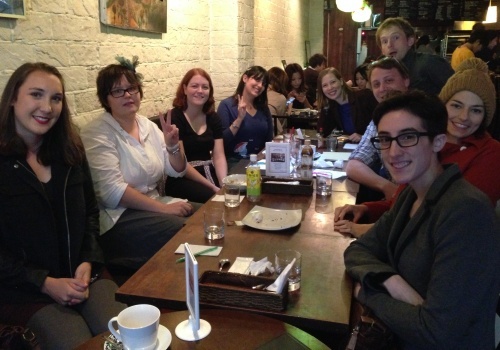

Sabrina Zirakzadeh is an eleventh year ML, and fifth year for Japan. She writes anything that inspires her, be it urban horror fantasy, teen romance, steampunk meta-fiction, or revenge thrillers. When she isn’t writing, she works as a freelance travel editor, English teacher, and performer in Osaka. She also writes songs and breaks the rules of music as frequently as she does the rules of fiction.
Top photo by Flickr user Moyan Brenn
Chris Baty's Blog
- Chris Baty's profile
- 63 followers



